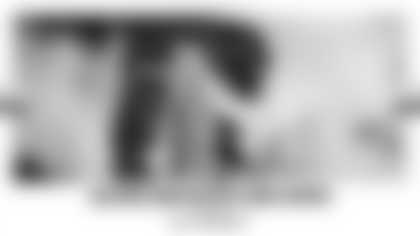RB Darren McFadden runs his 40-yard dash at the 2008 NFL Scouting Combine. The Raiders selected McFadden in the first round of the 2008 NFL Draft. AP Photo.
Each February, hundreds of the very best college football players are invited to the NFL Scouting Combine in Indianapolis, Ind., where executives, coaches, scouts and doctors from all 32 NFL teams conduct an intense, four-day job interview in advance of the NFL Draft. This year's Combine is scheduled for February 24 - March 1. You can learn more about the participants and count down to the 2011 NFL Draft with the Raiders.com Draft Prospects Series which will kick off with the quarterbacks on February 28th.
Here is a brief breakdown of the measurable drills:
40-yard dash
The 40-yard dash is the marquee event at the combine. It's kind of like the 100-meters at the Olympics: It's all about speed, explosion and watching skilled athletes run great times. These athletes are timed at 10, 20 and 40-yard intervals. What the scouts are looking for is an explosion from a static start.
Bench press
The bench press is a test of strength -- 225 pounds, as many reps as the athlete can get. What the NFL scouts are also looking for is endurance. Anybody can do a max one time, but what the bench press tells the pro scouts is how often the athlete frequented his college weight room for the last 3-5 years.
Vertical jump
The vertical jump is all about lower-body explosion and power. The athlete stands flat-footed and they measure his reach. It is important to accurately measure the reach, because the differential between the reach and the flag the athlete touches is his vertical jump measurement.
Broad jump
The broad jump is like being in gym class back in junior high school. Basically, it is testing an athlete's lower-body explosion and lower-body strength. The athlete starts out with a stance balanced and then he explodes out as far as he can. It tests explosion and balance, because he has to land without moving.
3 cone drill
The 3 cone drill tests an athlete's ability to change directions at a high speed. Three cones in an L-shape. He starts from the starting line, goes 5 yards to the first cone and back. Then, he turns, runs around the second cone, runs a weave around the third cone, which is the high point of the L, changes directions, comes back around that second cone and finishes.
Shuttle run
The short shuttle is the first of the cone drills. It is known as the 5-10-5. What it tests is the athlete's lateral quickness and explosion in short areas. The athlete starts in the three-point stance, explodes out 5 yards to his right, touches the line, goes back 10 yards to his left, left hand touches the line, pivots, and turns 5 more yards and finishes.


























